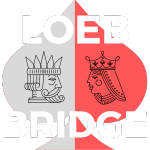A Negative Double is a takeout oriented double made by responder after an overcall. Negative Doubles apply at any level, but is likely to be converted for penalty at high levels The higher the bidding, the more values a Negative Double shows.
- 6+ points at the 1-level
- 8+ points at the 2-level
- 10+ points at the 3-level
As the available bidding space on a level shrinks, you get closer to the points expected at the next level. Both the 1♣ - (2♠) - X auction and the 1♦ - (3♣) - X auction expect opener to bid at the 3-level. So both show 10+ points. On an auction like1♣ - (3♠), a Negative Double shows game forcing or better values.
Penalizing an Overcall
Playing Negative Doubles gives up responder's penalty double. The way to penalize an overcall is for responder to pass, hoping opener balances with a takeout oriented double which responder will convert for penalties. Knowing the responder doesn't have a penalty double available, opener should strain to balance with a double when feasible.
Special Auctions
There are some auctions which must be memorized:
- 1♣ - (1♦) - X shows both majors
- 1♣/1♦ - 1♥ - X shows exactly 4 spades and another place to play
- 1♠ - (2♥) - X and 1♥ - (1♠) - X , show both minors
If there is an unbid major, a Negative Double shows the unbid major and another place to play. If responder has 5+ cards in the unbid major, but lacks the strength to bid their major, responder may begin with a Negative Double and then show their major. For example, after 1♦ - (1♠), a responder with ♠73 ♥KQJ65 ♦Q9 ♣T872 doesn't have the strength to bid 2♥, Responder can compete in hearts by making a Negative Double and then showing hearts. This denies the 10+ points needed to bid 2♥ immediately.
Negative Doubles apply at any level. If the auction begins 1♦ - (4♠), responder isn't likely to have a spade holding like ♠AQT3 where they want to penalize the overcall. A high-level Negative Double is takeout oriented and shows values. High level Negative Doubles are typically converted for penalty. After a high level overcall limits responder's options, responder's best action will sometimes be a Negative Double even if responder doesn't have the right shape. Opener should keep this in mind after a high level Negative Double.
Opener's Rebid
Opener rebids normally based on the shape and strength shown by responder’s Negative Double. Since responder doesn’t have a penalty double available, opener should strive to balance with a takeout oriented double when feasible. If responder wants penalize an overcall, they pass initially. If opener balances with a takeout oriented double, responder converts the double for penalty. That is how a pair playing Negative Doubles penalizes an overcall.
How to use the extra bidding space certain Negative Doubles at the 1-Level provide
1♣/1♦ - 1♥ - X shows exactly 4 spades. A jump by opener to 3♣ shows 4+ spades and 16-17 points. A jump to 4♠ shows 18+ points and 4 spades. It denies shortness if you play splinter bids. Here is how you should use a 1♠ and 2♠ rebids by opener:
1♠ shows 3-card spade support and a flaw for rebidding 1NT, or it shows an 11-12 point hand with 4 spades. A jump to 2♠ shows a 13-15 point hand with 4 spades. This same approach applies to both hearts and spades on the 1♣ - (1♦) - X auction which shows both majors.
For more on this topic, see Billy Miller's "The Magical Level" article.




